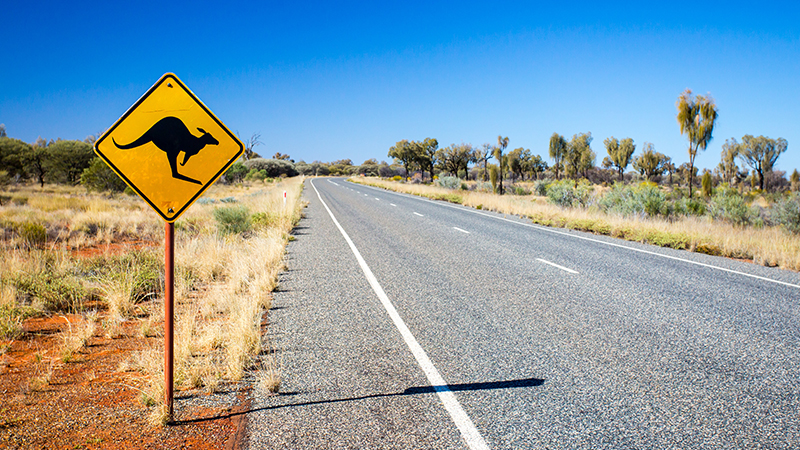Keen to drive in Australia? While the country’s population is only the 54th biggest in the world, Australia has the 9th longest network of roads, with a total of almost 900,000km. So there’s plenty to explore on four (or two) wheels! Here we look at how you can use the licence from your own country to legally use the roads, and when you need to apply for an Australian driver’s licence.
(Note that there are variations in regulations across Australia’s eight different states and territories – New South Wales, Victoria, Queensland, South Australia, Western Australia, Tasmania, the Northern Territory and the Australian Capital Territory. It’s a good idea to check with the road agency for the particular place you’ll be driving. You can find a list of links to all of them here.)

Driving in Australia for temporary visitors
Most visitors from overseas who don’t have a permanent visa for Australia can use an international driving permit (IDP) or their foreign licence when driving here. You’ll be classified as a “visiting driver” and will need to carry this licence with you whenever you’re driving.
For most states and territories, there is no time limit for using your foreign licence for temporary visitors. However, in New South Wales and Victoria, there’s a limit of six months, and it’s just three months in the Northern Territory.
Note that you can only drive the same category of vehicle in Australia that your licence from home allows you to drive. (So, you can’t drive a large truck if your overseas licence is only for a car.) If your overseas driver’s licence isn’t in English, you’ll also need an original, authorised English translation of your licence.
You can only use your licence from home if it’s valid. If it expires, for instance, you have to apply for an Australian licence instead.
Licences for permanents residents and citizens
Deciding to move to Australia permanently? You’ll need to apply for an Australian issued driver’s licence.
This requires completing a licence application form for the particular state or territory where you reside, gathering all the necessary documents for that jurisdiction (permanent residency, proof of identity and so on – translated into English if needed) and then visiting a driving service centre to submit everything.
After you’ve lodged your application and done any relevant tests (see the section below), you’ll be issued with a driver’s licence for your state or territory. You can use that licence to drive anywhere in Australia.
Do I need to do a driving test if I hold a foreign driver’s licence?
It depends. Most states and territories use a system known as “Recognised Countries”; if you’re from a country on this list, you may not need to do a test to get an Australian licence. Or you may find there is an A list and a B list; those from a country on the A list don’t require a test, whereas those from somewhere on the B list don’t require a test unless they are under 25 years of age, and then they do.
If you’re not from one of these Recognised Countries, you will likely need to pass both a theoretical test of your driving knowledge and a practical driving test with an examiner when applying for a licence equivalent to your overseas licence.
(Note: Aside from “Recognised Countries”, there is also a different list of countries/jurisdictions with “Experienced Driver Recognition”. This system is changing, and the list will no longer apply from 30 April 2025.)
Learning to drive
Moving to Australia and never driven a car? You can apply for an Australian licence if you have a valid visa or permanent residency status. Each state and territory has its own process for this, but the way it generally works is that, if you’re over the age of 16, you can do a knowledge test to obtain a Learner’s permit (known colloquially as “L’s”). You’re then required to do a certain number of supervised hours of driving. (This can be up to 120 hours in some states.) Next, you can book a practical driving test to obtain a Provisional permit (known as “P’s”). This usually can be transferred to a regular licence after a period of two years.
10 other things to know about driving in Australia
- Australians drive on the left-hand side of the road.
- The speed limit in built-up areas in Australia is usually 50 kilometres per hour, or less if sign-posted. Other roads have a maximum speed of 100 kilometres per hour, or 110 on some stretches of highway.
- Make sure you’re up to date with Australian road rules and familiar with signs.
- There are toll roads in many big cities and on the network of major highways. You’ll need an electronic tag to pay for these, though you can pass through them and then pay the toll later (usually within 3 or 5 days) if you don’t have a tag. Keep an eye out at the toll for a sign with a phone number or website for paying.
- It’s illegal to use a mobile phone while driving in Australia. To use a phone for navigation purposes, it must be in a hands-free cradle.
- Most vehicles in Australia run on unleaded petrol, though thing like campervans and four-wheel-drive vehicles may use diesel.
- A petrol station in Australia is known colloquially as a “servo” (short for “service station”). Bigger ones have a range of services and amenities, including restrooms, restaurants and more.
- Australia’s mobile phone network is always improving, but there are lot of rural areas where you shouldn’t rely on having coverage for navigation.
- If you’re driving into a remote area, let people know where you’re going, take plenty of extra fuel and water, and be aware of the state of the roads and any potential challenges or dangers.
- When it comes to driving etiquette in Australia, be aware that using a horn is rare here, except in emergencies. You’ll also find that drivers signal “thank you” (usually with the quick raise of a finger or hand) if you let them merge in front of you or overtake you on a narrow road.



